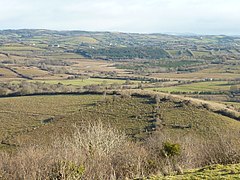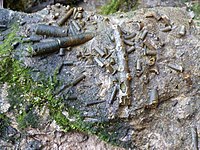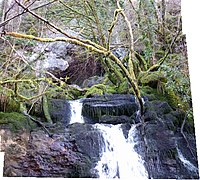Drumbegger
| Drumbegger TOWNLAND | |
| Fermanagh | |
|---|---|
 In Drumbegger, with the Sillees River | |
| Location | |
| Location: | 54°22’49"N, 7°50’24"W |
| Grid reference: | H104479 |
| Data | |
Drumbegger is a townland in Fermanagh, and part of the civil parish of Boho in the Barony of Magheraboy. It contains the sub-townland known as Oubarraghan.[1]
The name 'Drumbegger' might mean 'Ridge of the little tillage'.[2]
This area has been designated an Area of Special Scientific Interest as a consequence of species-rich wet grassland.[3]
Drumbegger Species Rich Wet Grassland
Habitats described as species rich wet grasslands are rare in Northern Ireland and are typically located in areas where traditional farming practices are still maintained.[3] The meadows are categorised by botanists/ecologists as Fen-meadow, a specific type of purple moor-grass, rush pasture that is fed by a steady hydrological influence.
The typical species found in Drumbegger are Devil’s-bit scabious (Succisa pratensis), sharp-flowered rush (Juncus acutiflorus), meadow thistle (Cirsium dissectum), lesser spearwort (Ranunculus flammula) together with mosses such as glittering wood-moss (Hylocomium splendens) and neat feather-moss (Pseudoscleropodium purum).[3] Drumbegger is also noteworthy as a habitat for two protected species, blue-eyed-grass (Sisyrinchium bermudiana) and the marsh fritillary butterfly (Euphydryas aurinia). Marsh fritillary caterpillars thrive on two plant species found in Drumbegger which are blue-eyed-grass and Devil’s-bit scabious.[3]


Screenagh River and Arch Cave
The Screenagh river enters Drumbegger from the subtownland of Oubarraghan from the Arch Cave (H10374790) which is itself an outlet of a series of subterranean passages originating from Noon's Hole.[4] The river is a tributary of the Sillees River which feeds into Lough Erne.
The waterfall and the cave were described by the famous French speleologist Édouard-Alfred Martel on 14 or 15 July 1895. On this occasion he was aided by the Enniskillen archeologist Thomas Plunkett (who had previously discovered Moylehid ring cairn in Boho) and Lyster Jameson a Dublin born naturalist. Martel correctly deduced that Noon's hole and the Arch Cave were linked by a series of underground chambers.[5]
See also
References
- ↑ Boho Heritage Organisation (2009). Edel Bannon. ed. Boho Heritage: A treasure trove of history and lore. Nicholson & Bass Ltd, Mallusk, Northern Ireland. pp. 246. ISBN 978-0-9560607-0-9.
- ↑ Drumbegger - Placenames NI
- ↑ 3.0 3.1 3.2 3.3 ASSI listing Drumbegger
- ↑ "Earth Science Conservation Review". National Museums Northern Ireland. http://www.habitas.org.uk/escr/site.asp?item=1161.
- ↑ Martel, Édouard-Alfred. (1897). British caves and speleology (Reprinted from: Geographical journal (Nov. 1897) ed.). Royal College of Surgeons of England: Royal College of Surgeons of England. p. 504. http://wellcomelibrary.org/item/b22473075#?c=0&m=0&s=0&cv=0&z=-0.2786%2C-0.0855%2C1.5572%2C1.7098. Retrieved 2016-08-04.